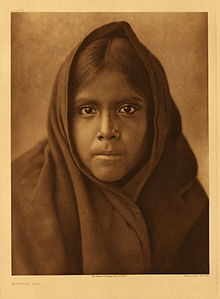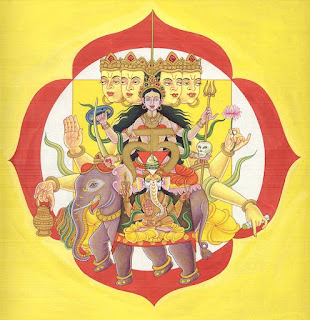Qahatika Girl, Edward Curtis, ca 1908.
About forty miles due south of the Pima reservation, in five small villages, one sees a type of the true desert Indian — the Qahátika. When or why they separated from their Pima kindred on the Gila and wandered into this inhospitable desert is a question on which even Indian tradition is vague. Many years ago, they say, the Pima were living at Akichính, near the Picacho, when a large party of Apache made war on them and drove them away. The greater part went to the Gila and established the settlement at Sacaton; others, the ancestors of the Qahatika, went into the desert and made their homes there. One traversing this region would have cause to wonder how a human being could wrest from so barren a land the necessities of life. It is only the life of meager requirement that could exist here; fortunately it is a land of warmth and sunshine, requiring little clothing. In primitive days, when the struggle was hardest, the men wore merely a loin-cloth, and the women a short skirt of yucca fibre. By gleaning the whole desert of its plant and animal products they managed to eke out an existence, becoming in time not only satisfied, but quite attached to their desolate, inhospitable surroundings. When asked why they do not go to the river valleys, where they might have good farms and live in plenty, their answer is that their home is the best; that they do not have sickness as do the River Indians.
Their never-ending struggle with the hostile desert seems to have left its mark on the Qahatika and has made them as repellent as the thorny vegetation itself. No vestige of the courtesy of the Pima or the Papago is seen among them, and mentally they are decidedly inferior. Not only is this noticeable to the visitor, but it is recognized by the kindred tribes and accounted for by the Papago in their creation myth. They still depend mainly upon the natural food supply, such as mesquite pods and cactus fruits. In locating their villages they selected spots where the natural drainage of a large area concentrates, hence they depend wholly on storm water for their crops. Theirs might well be termed “dry farming.” If there is no natural rise of ground about their little fields, a low embankment is thrown up to retain the flood water of the winter rains. The soft, loose soil absorbs moisture to a great depth, and a few heavy winter rains assure the Qahatika of a fair crop. They plant wheat in December, and harvest in May or June. It is cut with the sickle, and threshed in the Southwestern mode, by driving horses over the loose grain spread on the ground.
In appearance and habits the Qahatika are almost identical with the Pima and the Papago. Though different materials are used in the making of their houses, the form is the same. Mesquite, cottonwood, and willow provide an abundance of building material for the river tribes, but these mid-desert lovers depend solely on the woody ribs of the giant cactus. When the cactus tree dies, the pulpy tissue desiccates, leaving what looks like a bundle of weather-bleached poles. One cannot help wondering how these Indians would have managed if Nature had made the giant cactus with a solid trunk. Here at the rock-strewn foot of the desert mountain, where scarcely any other form of vegetable life seems able to exist, provident Nature permits this variety of cactus to flourish, and to furnish unlimited quantities of food as well as material for the building of habitable houses. Qahatika handicraft shows considerable skill, particularly in pottery, many forms of which are made. All household utensils are of their own manufacture, besides which many small pieces are made for barter.
Some examples are evidently copies of commercial ware, but many show true primitive feeling in form as well as in decoration. These Indians model, polish the ware, burn it to its rich red color, then
decorate and re-burn it. The paint for decorating is obtained by boiling chips of mesquite wood to a syrup, which is applied with a brush made by chewing a strip of yucca leaf. In the burning, the painted designs turn a brilliant black, making a very pleasing contrast with the bright red color of the ware. The Qahatika also make many excellent baskets of the usual Pima form and designs.
www.wikipedia.com
www.worldwisdom.com
LAMAT
Kin 128: Yellow Spectral Star
I dissolve in order to beautify
Releasing art
I seal the store of elegance
With the spectral tone of liberation
I am guided by my own power doubled.
Thinking layers are strata in the ocean of consciousness which interpenetrate various dimensions.*
*Star Traveler's 13 Moon Almanac of Synchronicity, Galactic Research Institute, Law of Time Press, Ashland, Oregon, 2015-2016.
The Sacred Tzolk'in
Muladhara Chakra (Seli Plasma)





No comments:
Post a Comment